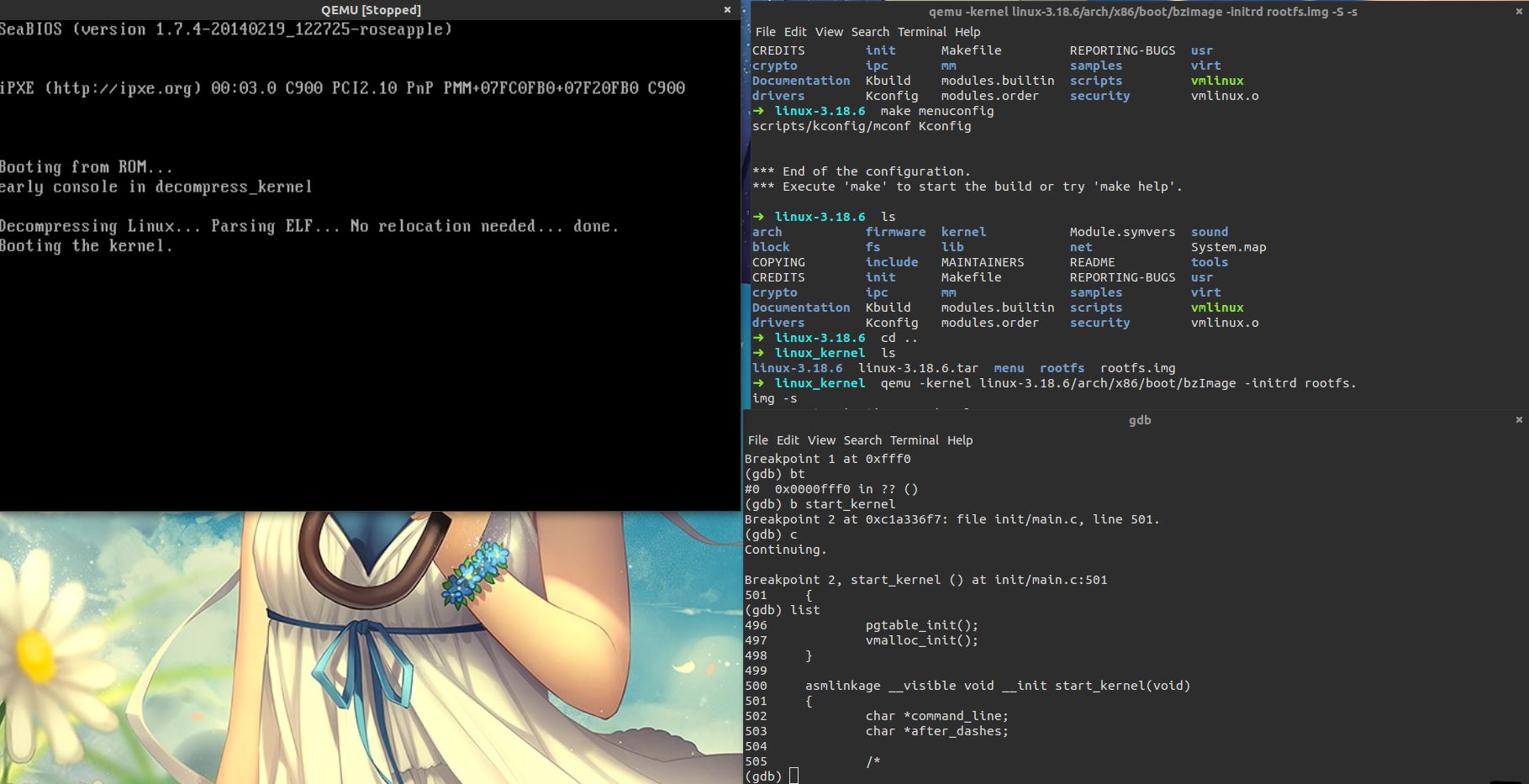通过从代码层面分析Linux内核启动来探知操作系统的启动过程
通过从代码层面分析Linux内核启动来探知操作系统的启动过程
前言说明
本篇为网易云课堂Linux内核分析课程的第三周作业,我将围绕Linux 3.18的内核中的start_kernel到init进程启动过程来深入探知操作系统的启动,文中的代码来自Linux Kernel Organization的3.18.9内核源码
本篇关键词:init进程,idle进程,Linux内核启动
分析
分析说明
- 分析过程将把主要精力放在关键代码的分析上,代码分析的方式我是采用注释说明的方法,这样比较简洁直观,对于一些关键过程我会在代码后面采用图文说明的方式。
- 文中我已经将3.18内核代码编译,而且加入debug调试信息,由于这里的过程在课堂上已经有详细讲解,这个过程我就不在赘述。
/* star_kernel是linux内核入口 */
asmlinkage __visible void __init start_kernel(void)
{
char *command_line;
char *after_dashes;
/*
* Need to run as early as possible, to initialize the
* lockdep hash:
*/
lockdep_init();
set_task_stack_end_magic(&init_task);
smp_setup_processor_id();
debug_objects_early_init();
...
boot_cpu_init();
page_address_init();
pr_notice("%s", linux_banner);
setup_arch(&command_line);
mm_init_cpumask(&init_mm);
setup_command_line(command_line);
setup_nr_cpu_ids();
setup_per_cpu_areas();
smp_prepare_boot_cpu(); /* arch-specific boot-cpu hooks */
...
build_all_zonelists(NULL, NULL);
page_alloc_init();
...
setup_log_buf(0);
pidhash_init();
vfs_caches_init_early();
sort_main_extable();
trap_init();
mm_init();
...
/* Do the rest non-__init'ed, we're now alive */
rest_init();
}
init/main.c- 以上为
start_kernel函数的一个代码片段,在该函数之前的执行都是汇编,以C语言程序的思维来看,start_kernel就是整个Linux内核的“main”函数,即整个Linux内核的入口函数,在start_kernel中,开始有一个set_task_stack_end_magic(&init_task),这个函数中间的形参init_task,通过寻找在init/init_task.h中找到了struct task_struct init_task = INIT_TASK(init_task)(struct task中保存进程的相关信息,类似PCB),经过初始化init_task后,静态构造进程,这是Linux第一次拥有了进程,这就是后来的idle进程(pid为0),从start_kernel之前的汇编代码到start_kernel执行,这里都会纳入idle进程的上下文(之前的汇编代码就是为了idle进程的执行做准备)。 - 最后
rest_init()标志着Linux内核初始化完成,在rest_init()中开始产生第一个真正意义上的进程,也就是init进程(即进程号为1的进程,其他所有用户进程的祖先进程),接下来就对rest_init()部分做详细分析
static noinline void __init_refok rest_init(void)
{
int pid;
rcu_scheduler_starting();
/*
* We need to spawn init first so that it obtains pid 1, however
* the init task will end up wanting to create kthreads, which, if
* we schedule it before we create kthreadd, will OOPS.
*/
kernel_thread(kernel_init, NULL, CLONE_FS);
numa_default_policy();
pid = kernel_thread(kthreadd, NULL, CLONE_FS | CLONE_FILES);
rcu_read_lock();
kthreadd_task = find_task_by_pid_ns(pid, &init_pid_ns);
rcu_read_unlock();
complete(&kthreadd_done);
/*
* The boot idle thread must execute schedule()
* at least once to get things moving:
*/
init_idle_bootup_task(current);
schedule_preempt_disabled();
/* Call into cpu_idle with preempt disabled */
cpu_startup_entry(CPUHP_ONLINE);
}
kernel/forkkernel_thread(kernel_init, NULL, CLONE_FS),这里通过这个函数创建了init进程,该函数具体代码如下:
pid_t kernel_thread(int (*fn)(void *), void *arg, unsigned long flags)
{
return do_fork(flags|CLONE_VM|CLONE_UNTRACED, (unsigned long)fn,
(unsigned long)arg, NULL, NULL);
}
第一次参数为注册一个回调函数,kernel_init这个回调函数,do_fork是创建一个新的进程, 在此之中会为创建init进程进行各种工作,如初始化运行堆栈,调用相应的回掉函数等,通过回调kernel_init可以创建init进程,接下来具体分析下kernel_init
static int __ref kernel_init(void *unused)
{
int ret;
kernel_init_freeable();
/* need to finish all async __init code before freeing the memory */
async_synchronize_full();
free_initmem();
mark_rodata_ro();
system_state = SYSTEM_RUNNING;
numa_default_policy();
flush_delayed_fput();
if (ramdisk_execute_command) {
ret = run_init_process(ramdisk_execute_command);
if (!ret)
return 0;
pr_err("Failed to execute %s (error %d)\n",
ramdisk_execute_command, ret);
}
/*
* We try each of these until one succeeds.
*
* The Bourne shell can be used instead of init if we are
* trying to recover a really broken machine.
*/
if (execute_command) {
ret = run_init_process(execute_command);
if (!ret)
return 0;
pr_err("Failed to execute %s (error %d). Attempting defaults...\n",
execute_command, ret);
}
if (!try_to_run_init_process("/sbin/init") ||
!try_to_run_init_process("/etc/init") ||
!try_to_run_init_process("/bin/init") ||
!try_to_run_init_process("/bin/sh"))
return 0;
panic("No working init found. Try passing init= option to kernel. "
"See Linux Documentation/init.txt for guidance.");
}
init/main.c- 在
kernel_init中我们重点关注以下代码,在这段代码中实际上是通过run_init_process来执行/sbin/init,通过中断向量0x80(system_call)来从内核发起系统调用,如果/sbin/init调用失败,则会继续调用接下来的文件/etc/init,/bin/init,/bin/sh,
...
if (!try_to_run_init_process("/sbin/init") ||
!try_to_run_init_process("/etc/init") ||
!try_to_run_init_process("/bin/init") ||
!try_to_run_init_process("/bin/sh"))
return 0;
...
接下来我们回到rest_init的代码片段,rest_init执行完后,idle进程已经结束了他的使命,开始成为一个真正的idle进程,即真正的空闲进程,从这里开始内核的初始化真正结束了,用户态的阶段开始了
//rest_init
...省略
/*
* The boot idle thread must execute schedule()
* at least once to get things moving:
*/
init_idle_bootup_task(current);
schedule_preempt_disabled();
/* Call into cpu_idle with preempt disabled */
cpu_startup_entry(CPUHP_ONLINE);
- 这里的
cpu_startup_entry(CPUHP_ONLINE)中的代码片段
void cpu_startup_entry(enum cpuhp_state state)
{
...代码省略
arch_cpu_idle_prepare();
cpu_idle_loop();
}
static void cpu_idle_loop(void)
{
while (1) {
...代码省略
__current_set_polling();
tick_nohz_idle_enter();
...
arch_cpu_idle_enter();
arch_cpu_idle_exit();
...
schedule_preempt_disabled();
...
- 我们在这里看到一个
cpu_idle_loop(),这里其中是一个死循环,而且从中可以看到CPU不断地进入idle状态不断的推出idle状态。 - 从这里我们可以得到一个这样的结果并总结,idle进程是一个内核态进程,init进程是Linux系统刚刚开始有了进程概念下的进程,其最后会进行从内核态转向用户态,idle进程在内核初始化的时候的工作就是创建init进程。
我对Linux系统启动过程的一点理解
首先,启动计算机,载入汇编代码,直到start_kernel执行的这个阶段,idle进程(0号进程)就是从这个时间段产生的,这个阶段为idle执行上下文做准备,start_kernel的init_task就是idle进程(此时还没有Linux进程,仅仅是模拟的一个进程),然后在rest_init初始化并产生init进程(1号进程),整个操作系统开始从内核态向用户态转换。
截图

署名信息
吴欣伟 原创作品转载请注明出处 《Linux内核分析》MOOC课程: http://mooc.study.163.com/course/USTC-1000029000




